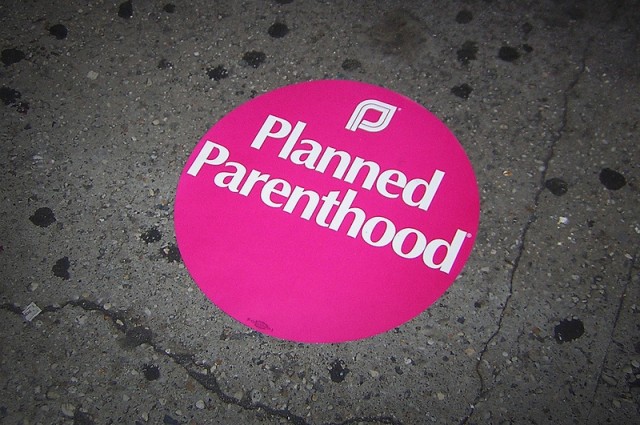This article is part four of a series on the history of Planned Parenthood. Read parts one, two, and three.
While Planned Parenthood was founded in 1942 by eugenicist Margaret Sanger, the organization didn’t open its first abortion facility until 1970. The decision to push for decriminalization of abortion and then subsequently begin committing abortions was brought in under Alan F. Guttmacher, a former vice president of the American Eugenics Society and president of Planned Parenthood in the 1960s, long after Margaret Sanger’s departure.

Alan F. Guttmacher, 1973
In Live Action News’ series on this subject, we previously documented how former Planned Parenthood Federation of America (PPFA) president, Alan F. Guttmacher began advocating for abortion years before taking the helm of Planned Parenthood in 1962. Then, in 1968, under Guttmacher’s leadership, Planned Parenthood’s board approved a resolution to begin calling for the decriminalization of abortion and offering abortion referral services. It was passed the following year.
In this report, readers will learn about Planned Parenthood’s first abortion facility, which opened in 1970. George Langmyhr, chair of Planned Parenthood’s Medical Committee and the Association of Reproductive Health Professionals (ARHP) at that time, detailed the organization’s abortion genesis, writing in 1971, “It goes without saying that Planned Parenthood Affiliates have long been involved in programs of abortion information, counseling and referral.”
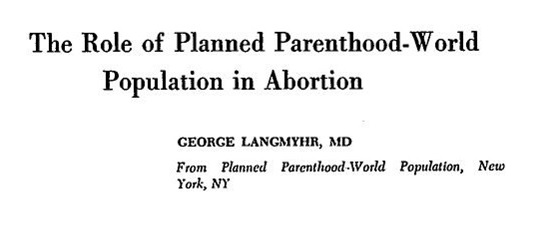
George Langmyhr writes about Planned Parenthood first abortion facility
Langmyhr added:
I think it is fair to say that most professionals and volunteers associated with Planned Parenthood have accepted, for a long time, the necessity of abortion as an integral part of any complete or total family planning program. In 1969, Planned Parenthood-World Population passed a policy on abortion. Further, the National Medical Committee has issued Standards for Pregnancy Counseling Programs and Abortion Services.
Planned Parenthood began its journey to abortion with a “pregnancy detection” service
Langmyhr called Planned Parenthood’s early role in abortion activities “necessarily unpublicized,” pointing to “the outspoken advocacy of abortion law change by Dr. Alan Guttmacher” and going on to detail the organization’s involvement in abortion information, counseling, and referrals following the “advent of abortion reform movements,” as well as Planned Parenthood’s role in pregnancy detection, “clergy counseling,” national abortion hotlines, and the opening of abortion facilities.
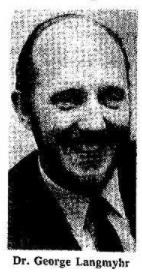
George Langmyhr Planned Parenthood medical committee
Langmyhr explained just how Planned Parenthood affiliates became so involved in abortion:
In a programmatic way, Planned Parenthood began to get more deeply involved in abortion programs through its involvement in pregnancy detection services. In many communities, Planned Parenthood patients complained that it was virtually impossible to get a pregnancy test done easily and cheaply; this was verified by Affiliate personnel, upon checking these complaints. When attempting to prod health departments or hospitals, they found many institutions resistant to developing or implementing a pregnancy detection service. Therefore, many affiliates assumed this responsibility, at least on a temporary basis. When Planned Parenthood’s efforts became known, affiliates were confronted with an increasing number of women seeking pregnancy detection services who also began to request other assistance if they were found to be pregnant. Thus, certain affiliates began to get more deeply involved in abortion information, counseling and referral.
Up to this point, Planned Parenthood’s role was advocacy for the decriminalization of abortion as well as abortion referral in states such as New York, Colorado, and California, which had already changed their strict abortion laws. But in 1968, shortly after the Association of Reproductive Health Professionals liberalized its abortion stance, Planned Parenthood followed suit. An article written just after members of all 158 Planned Parenthood affiliates were presented with the change quotes Langmyhr as claiming that not all of Planned Parenthood’s members were on board.
“The great majority of the affiliated members are much in favor of the statement,” Langmyhr told the Charleston Gazette on December 30, 1968. But not all. “Just a week before the policy statement was made, a Washington D.C. based member said, ‘We don’t talk about abortion. We’ve had enough of a fight just getting birth control across.'” However, the paper noted that others felt Planned Parenthood had “dragged its feet much too long on the subject of abortion.”
From “pregnancy detection” to “abortion guidance”
Langmyhr then admitted that “[p]rior to 1965, when we were still walking the tight rope, getting those birth control laws repealed, it made little sense to get on to abortion.” He told the Gazette that his affiliates were being encouraged to give “abortion guidance” to all their patients. “Up until now they’ve been given the run around in most instances, even where there were indications they might be legally able” to have therapeutic abortions, Langmyhr said, adding that a lot of Planned Parenthood groups were working with others to change the laws.
In 1970, Planned Parenthood-World Population published a booklet to assist women in obtaining abortions. “Legal abortion: A guide for women in the United States,” was written by Langmyhr and Walter C. Rogers, MD.
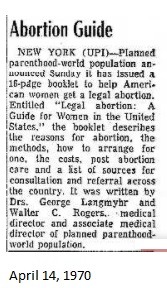
Abortion Guide published by Planned Parenthood
In the booklet, Langmyhr called abortion a “proper medical back-up technique.” And, as is often done today, he also dehumanized the preborn child in the womb by referring to him/her as “the pregnancy.” The booklet, published three years prior to the Roe v. Wade Supreme Court decision, tells readers how to obtain an abortion by seeking the help of a select number of organizations including Planned Parenthood: “If you have a doctor you see regularly, ask him about getting an abortion. Or, call the Planned Parenthood affiliate in your community.” The booklet then published a list of every affiliate’s location and telephone number. And, of course, Langmyhr was sure to advise his readers that they seek birth control or sterilization from the organization as well.
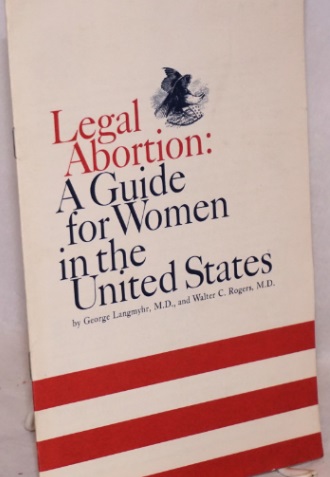
Legal Abortion: A Guide for Women by George Langmyher
Planned Parenthood president Guttmacher suggests idea of “abortoriums” – free for poor women
In anticipation of New York decriminalizing its state abortion laws in 1970, Planned Parenthood’s president Alan F. Guttmacher suggested that “special facilities,” which he called “abortoriums,” should be opened. These “abortoriums” would supposedly do well if they charged one-third of the patients $150 to $200 and performed free abortions for poor women.
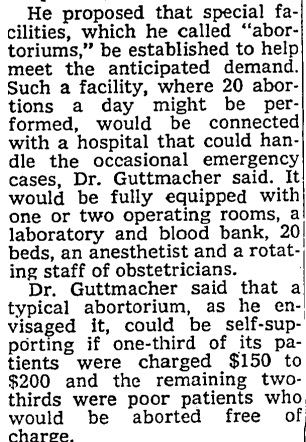
Planned Parenthood prez Alan Guttmacher suggests abortoriums in 1970 (Image New York Times)
Also in that April 1970 article, the paper reported that the membership of the American Association of Planned Parenthood Physicians (AAPPP) voted unanimously to recommend that the medical profession make “easily available to all women” whatever aid they may need to prevent birth, including abortion. The resolution also urged the “abolition of all statutes and criminal laws which in any way restrict the performance of abortion by licensed physicians.”
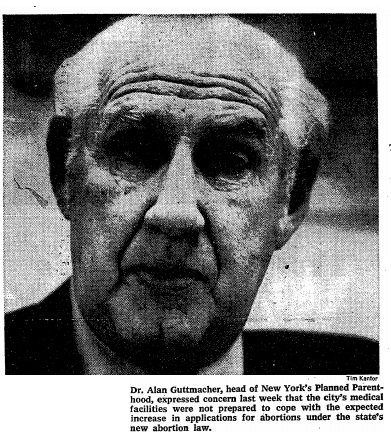
Alan Guttmacher on abortion 1970 (Image New York Times)
The AAPPP was founded by Dr. Guttmacher in 1963 and was renamed the Association of Reproductive Health Professionals (ARHP) in 1987. According to the ARHP, the AAPPP was based out of Planned Parenthood offices and was funded in large part by the organization. According to APHA history:
Guttmacher had recognized a need for a forum in which physicians could learn about and discuss advances in the field of family planning and formed AAPPP…. Funded largely by Planned Parenthood, with some small grants from pharmaceutical companies and membership dues from roughly 650 members… AAPPP had volunteer leadership, no staff and no office space of its own. The thread holding together its members was the annual meeting and the publication Advances in Family Planning. The thread was held by Planned Parenthood, from which AAPPP drew its very lifeblood: AAPPP’s funding came largely from Planned Parenthood, nearly all its members were Planned Parenthood physicians, and it was based in the Planned Parenthood offices in New York, with part-time administrative support from Planned Parenthood.
A May 25, 1970, article published by New York Magazine documents how Guttmacher, nicknamed the “dean of abortion faculty,” wanted to “rent a loft or store, equip it with surgical equipment and about 20 recovery beds and go into the large scale abortion practice.”
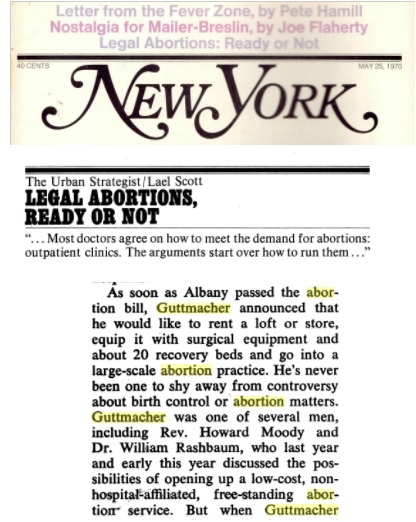
Guttmacher large scale abortion practice NY Magazine May 1970
The magazine went on to state, “Guttmacher would like to see the Planned Parenthood Association… set up facilities. In fact, the Planned Parenthood group in New York City is now thinking about setting up a clinic in the Borough Hall area of Brooklyn.”
Planned Parenthood made a big shift toward abortion over five years
In 1966, according to the New York Times, Planned Parenthood of New York had just 42 locations. Shortly after New York liberalized its abortion laws, Planned Parenthood set out to open its first abortion facility. By 1971 — just five years later — Planned Parenthood had 100 centers throughout the city. In 1971, Langmyhr detailed the organization’s shift towards abortion, writing:
Planned Parenthood of New York City is currently considering the development of an outpatient abortion facility in order to provide prompt, safe, low-cost ($0- 150) outpatient abortions.
Our affiliate in Syracuse made the decision to perform abortions on its premises. You may know that Syracuse is a conservative, Catholic community. The affiliate began to plan its abortion facility when it became apparent that no hospitals in the area were making provision for abortion services. Through various surveys, it learned that a number of doctors were willing to accept referrals for abortions that would either be performed in the physician’s office or in the hospital with which the physician was associated.
Since July 1, 1970, approximately 12 pregnancies per week have been terminated in the Syracuse Planned Parenthood facility. Twenty percent of the patients are on welfare; the fees have ranged from $0 – 250, with the average payment being $150. The administrative problems in actually putting together the service were, to say the least, horrendous.
1970: Planned Parenthood Center of Syracuse becomes first affiliate to commit abortions
On July 1, 1970, Planned Parenthood Center of Syracuse became the first affiliate to offer abortions. The affiliate’s executive director, Ellen Fairchild, recalled the event and was quoted in Planned Parenthood’s book, “A Tradition of Choice,” as saying, “Before the legislature even passed the new law, Dr. Jeff Penfield, the medical director, and I had decided to challenge the state by opening up an abortion clinic. Of course we never expected the law to be passed. But, once it happened, we decided to wait until it took effect on July 1. We did four abortions that first day.”
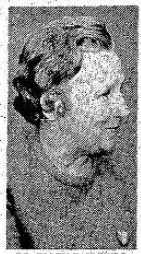 Ellen Fairchild opened first Planned Parenthood abortion clinic 1971
Ellen Fairchild opened first Planned Parenthood abortion clinic 1971
“We had the young and we had the desperate. We even had one whole family of sharecroppers come up from Mississippi because their 13-or 14-year-old girl was pregnant. They had read in the paper that we did abortions and we were the only place they had to turn,” Fairchild stated.
That same year, Mrs. Fred Schumachker, executive director of Planned Parenthood in Washington D.C., told the Elyria Chronicle Telegram, “You can have the most liberalized abortion laws in the world, but it won’t do any good without facilities and a hospital that allows it.”
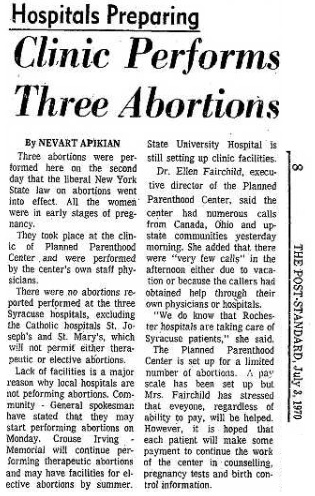
First Planned Parenthood abortion facility in US
The following year, the New York Times announced that Planned Parenthood was set to open an abortion facility in New York. Its executing vice president, Alfred F. Moran, noted that the facility would be a better option from what he called the “commercial profit-making abortion services” that were operating in the city. He called the facility a “prototype for the development of additional centers throughout the city, state and nation and will stimulate the conversion of so-called abortion clinics” into facilities that would also provide comprehensive birth control services.

Planned Parenthood Opens first abortion facility in 1970 (image New York Times)
Funds for the abortion facility were being set up by the Rockefeller Brothers Fund, the Scaife Family Trust of Pittsburgh, and an anonymous donor.
Moran told the media that they estimated doing about 80 abortions per week. He called the center “an example of how a family planning clinic can be successfully converted with relatively minor changes to provide abortions as well as birth control services.”
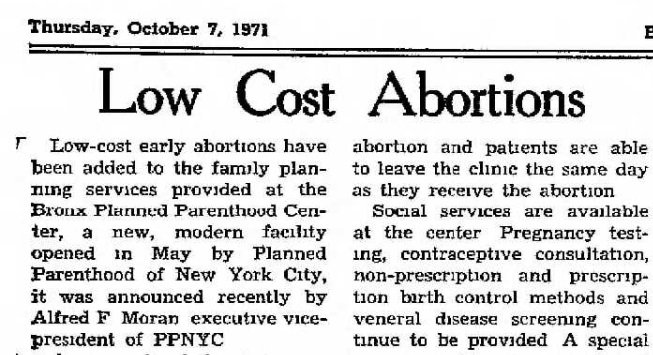
Planned Parenthood New York starts offering abortions
Moran suggested that eight to ten abortion clinics capable of doing nearly 100,000 abortions be set up across the city, costing in the range of $3-4 million. “That there would be a demand for terminations was clear from the affiliate’s experience with abortion counseling and referral service which had been established in 1968,” wrote Ellen Fairchild in April 1971.
The abortion facility, according to reports, was set up to perform more than 10,000 abortions per year on women less than 10 weeks pregnant. Under the state’s health code, Planned Parenthood was required to have a back up hospital within a ten minute drive from the clinic, which was Beth Israel Medical Center (also committing two thousand abortions annually), according to a New York Times report.
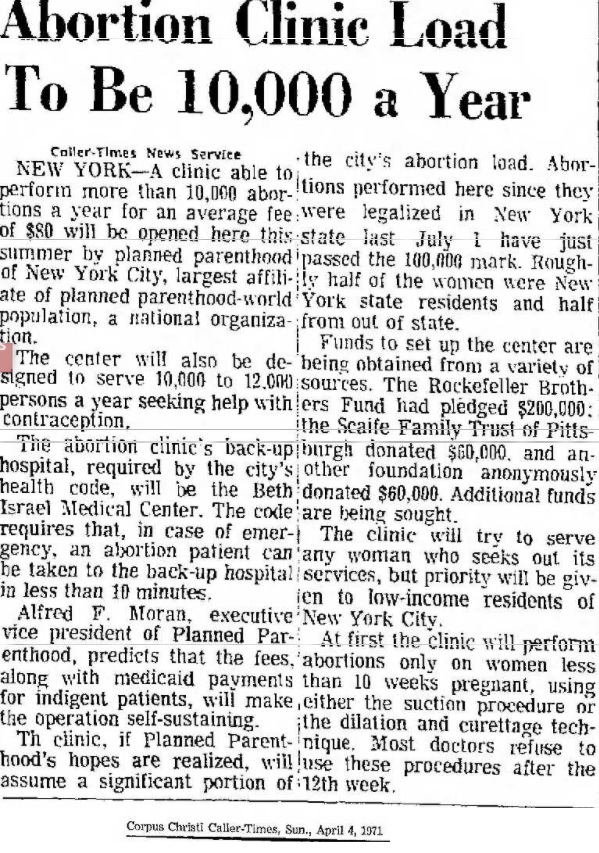
Planned Parenthood New York opens first abortion facility 1971
Within six months, Planned Parenthood of New York City began providing abortions on a larger scale in the Bronx.

Planned Parenthood to open first abortion clinic 1971 (Image: New York Times)
In testimony before Congress in 1972, demographer Randy Engel detailed what occurred next:
As of 1971, Planned Parenthood was operating at least three aboratoriums, including an out-patient center in Alameda-San Francisco area for “low-income” patients, a clinic in Syracuse, and one in New York which will perform 9,000-10,000 low cost abortions per year. In New York City, Planned Parenthood operates a Family Planning Services Information Service for the city, which gives information and makes referrals for birth control, voluntary sterilization, and abortion for city residents.
… Planned Parenthood, Milwaukee, for example has received a $150,000 grant from HEW [a Government agency at that time] which was matched by $75,000. This permitted PP to increase its services by 50% to include contraception, sterilization and “abortion referral.”
According to PP, abortion counseling and referral are “educational and political” as well as purely “service”, that is, a total program aimed at educating the public so as to “mold a new attitude” toward abortion: to “increase the number of therapeutic abortions performed under the law in the Bay area and throughout California; and to work for further liberalization of the law” and other objectives.
Planned Parenthood ultimately committed abortions for eugenic reasons
Planned Parenthood was not only referring for abortions, now they were also fully engaged in committing the procedure. But the organization’s overall agenda was the same: eugenics. Eugenicists like Guttmacher long identified abortion as the new “solution” to what was deemed a “population problem,” and other eugenics-minded advocates wasted little time joining Planned Parenthood in implementing their new plan.
Writing for the NYT, in 1971, author Virginia Lee Warren observed how Planned Parenthood was less about women and more about decreasing population growth:
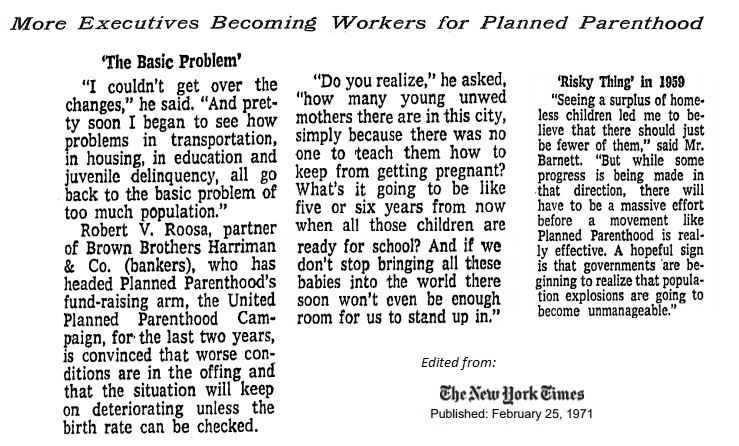
Men fund Planned Parenthood because of population and eugenics (Image New York Times)
Men, especially men in big business… have come to see that an excess of people can make life difficult for everyone…. The result, executives and corporation lawyers have been leaping into Planned Parenthood, especially into the money raising phase of it…. Indeed, so many men are now deep in the movement that on the national board of the organization they outnumber women 55 to 49…. Today, largely because of the men who have rallied to the cause, Planned Parenthood’s budget for this year is $20 million–20 times what it was when Cass Canfield led the way into the organization in 1959.
One of those men, Alan Guttmacher, wasted little time approaching the Planned Parenthood board to offer abortions nationwide after the Supreme Court legalized abortion in January of 1973. According to author Rose Holz, at a February 1973 PP-WP board meeting, Guttmacher insisted that Planned Parenthood begin offering on-site abortions for the poor. The former Eugenics Society VP, who had been calling for the decriminalization of abortion for years, saw it as a solution to the overpopulation problem and now seemed determined to take advantage of the court’s decision.
In Holz’s book, “The Birth Control Clinic in a Marketplace World,” she quotes Guttmacher:
What opportunity does the poor person have? Does she have equal opportunity for abortion as the affluent? I am not interested in the fact that private practitioners are changing their criteria for doing abortions because the law has changed. My only interest in this is what opportunity does the [poor] woman with the undesired, unplanned and rejected pregnancy have…. Unless this organization takes a strong stand in this area, I can’t believe that we are going really have a successful program in the United States.
Today, nearly 50 years since Planned Parenthood opened its first abortion facility, it has “successfully” become the nation’s largest abortion provider, marketing them to the poor and minorities from state to state. Due in part to the same type of philanthropists who financed them years ago along with millions in taxpayer dollars annually, this organization now commits more than one-third of the nation’s reported abortions. With Guttmacher’s abortion plan implemented, surely the abortion corporation’s eugenicist founder, Margaret Sanger, would be proud.

